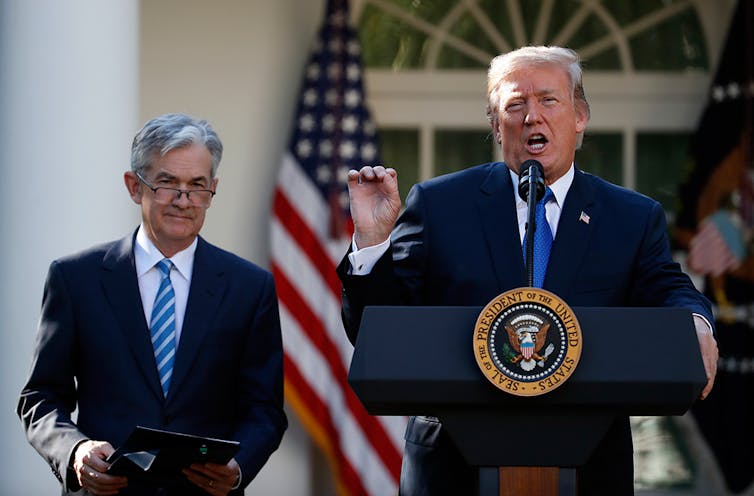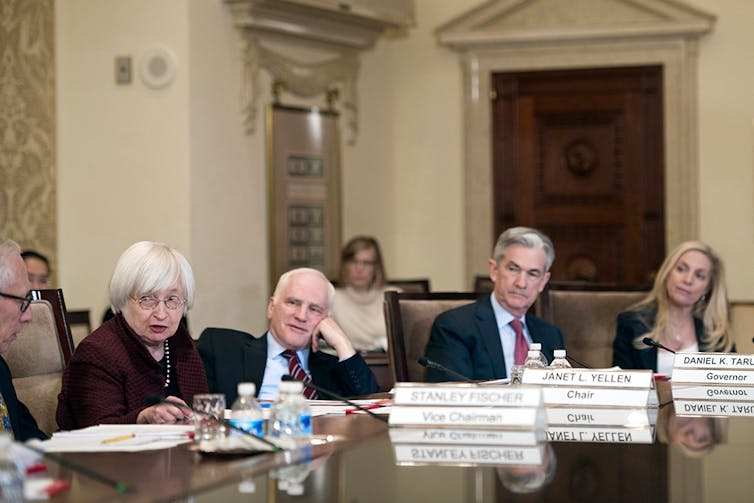Trump names 'safe' choice to lead the Federal Reserve: 5 questions answered
The chair of the Federal Reserve is often considered the world's 'second-most-powerful person.' So who is Jerome Powell and why does it matter that he may soon head the Fed?

Editor’s note: Markets breathed a sigh of relief after President Donald Trump named Jerome Powell his pick to be the next chair of the Federal Reserve. If confirmed, Powell – considered a “safe” choice – would take over from current Chair Janet Yellen in February, becoming one of the world’s most powerful people. So what’s the big deal? Economist Greg Wright explains why who leads the U.S. central bank matters to us all.
What does the Fed do?
The Federal Reserve oversees all banks and financial institutions based in the U.S., including branches of foreign companies, and also sets U.S. monetary policy.
The main way it does the latter is through its target interest rate. This benchmark influences the pace of economic growth, the level of employment and the price of goods, services and assets around the world. As the engine behind the world’s most important economy, the Fed’s influence is hard to overstate.
As a result, the Fed affects the likelihood that you – and millions of others around the world – will keep your job, will be able to afford a new home and will be able to retire when you want. And while most Fed decisions are made by a seven-member Board of Governors, the chair’s voice is by the far the most important. For this reason the Fed chair is sometimes referred to as the “second-most-powerful person in the world” – after the U.S. president.

How does the chair shape Fed policy?
The Fed’s mandate – as established by Congress – is easily stated but difficult to achieve. It seeks strong economic growth, maximum employment and stable prices. The second two aims are often referred to as the “Fed’s dual mandate,” since those are the main ways it seeks to achieve the first one: strong economic growth.
The main lever that the Fed can adjust to achieve these ends is its “target rate,” currently set at 1 percent to 1.25 percent. This short-term interest rate indirectly determines everything from stock prices to exchange rates to the cost of borrowing money for a new car or home.
As a result, the beliefs and background of the Fed chair matter a great deal.
Broadly speaking, experts in monetary policy fall within one of two camps: “hawks” and “doves.” Those considered “hawkish” are concerned more with the dangers of inflation – the pace at which prices change – and asset bubbles – when the price of an asset greatly exceeds its intrinsic worth – so they tend to want to raise interest rates at the first sign of either. In contrast, doves tend to focus on keeping the economy growing and, in particular, ensuring a strong labor market, which makes them more hesitant to raise rates, all else being equal.
Yellen, who has held the post since 2014, is considered a dove. Stanford economist John Taylor, who was favored to be the new Fed chair by many Trump donors and backers, is considered more hawkish. Powell is somewhere in between.
There are risks associated with each of these approaches. If the Fed raises interest rates too soon, the economy may fall into recession. On the other hand, if interest rates remain too low for too long, prices may rise faster than the Fed can control, which may lead to asset price bubbles. Some commentators believe the housing bubble that precipitated the recent financial crisis was a result of overly dovish monetary policy.
Nevertheless, dovish policies have recently won out in large part because, despite the strong economy, there has been very little inflation. The jury is out on whether we are in the midst of another asset bubble.

Who is Jerome Powell?
Powell is a Republican and a wealthy former investment banker who currently serves on the Fed’s Board of Governors. He was first nominated by President Barack Obama in 2012. Perhaps the most notable feature of his biography is that he lacks a background in economics, expertise that the previous three Fed chairs brought to the table.
Given that Powell has consistently expressed moderate views regarding monetary policy, the choice is seen as a cautious one, signaling that the Trump administration’s primary goal is to keep the global economy on its current path of steady growth and low unemployment. In short, Powell is expected to continue Yellen’s relatively dovish policies.
Why did Trump choose him?
At the same time, the other half of the Fed’s duties should not be forgotten: regulating U.S. financial institutions.
And in this regard, Powell’s nomination comes with a possible bonus for the administration, namely that he has expressed a desire to roll back some of the regulations imposed on the financial sector following the 2008 crisis. This fits with the administration’s larger push for deregulation of many aspects of the economy.
Any rollback would be a boon to the financial industry, but the fear is that it could also increase the likelihood of a future crisis. So far it is unclear how far Powell would go to relax the regulatory regime and to what extent he would target regulations that many commentators deem key to avoiding a future financial meltdown.

Why not keep Yellen?
For Yellen, it is an unusually abrupt exit, having served only one term – and a successful one at that. In addition, some commentators have lamented the relatively quick ousting of the first woman to hold the position, particularly in light of her strong performance.
Trump is breaking with precedent by not reappointing Yellen to a second four-year term. The previous three chairs were reappointed without controversy – and by a president of the opposing political party no less, largely to signal support for the apolitical nature of the Fed.
So why choose a new Fed chair at all?
It’s a risky time to change leadership. Most critically, the Fed is beginning the process of ending a decade of highly accommodative monetary policy during which interest rates were at unprecedented lows and the bank was pumping trillions of dollars into the financial system. The Fed is gradually increasing interest rates and slowly reducing the size of its balance sheet, which has swelled to US$4.5 trillion from under $1 trillion before the financial crisis.
The transition has the potential to be highly disruptive if mismanaged. Whereas the initial purchase of $3.7 trillion in assets was an unusual policy enacted during fairly desperate times, the process of unwinding it is unprecedented.
Simply put, no one is sure if it can be done without spooking markets or causing a recession. Who’s in charge at the Fed could be key to successfully navigating this process, which will take many years.
Greg Wright does not work for, consult, own shares in or receive funding from any company or organization that would benefit from this article, and has disclosed no relevant affiliations beyond their academic appointment.
Read These Next
From truce in the trenches to cocktails at the consulate: How Christmas diplomacy seeks to exploit s
World leaders like to talk up peace at Christmastime. But alongside the tales of seasonal breaks in…
As DOJ begins to release Epstein files, his many victims deserve more attention than the powerful me
Powerful men connected to Jeffrey Epstein are named, dissected and speculated about. The survivors,…
How to reduce gift-giving stress with your kids – a child psychologist’s tips for making magic and a
Depending on family circumstances and a child’s personality type, gift giving runs the gamut of fun…






